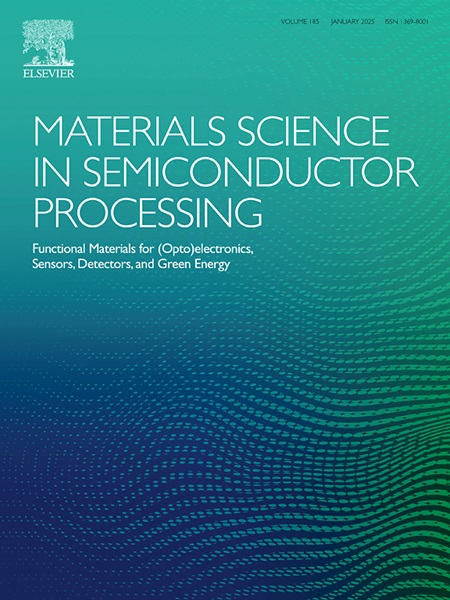Effect of aminoguanidine hydrochloride on chemical mechanical polishing of Ta-based barrier layers on TSV wafers
IF 4.2
3区 工程技术
Q2 ENGINEERING, ELECTRICAL & ELECTRONIC
引用次数: 0
Abstract
As the feature size of planar semiconductor processes gradually decreases, the development of chips to increase integration in the 2D direction gradually stagnates. Consequently, to keep pushing the boundaries of chip integration, the Through Silicon Via (TSV) technology as a representative of the 2.5D and 3D integrated circuits (IC) technology, has become the new type of solution. Chemical Mechanical Polishing (CMP) of TSV is a key process to ensure the surface flatness of silicon through-holes, to remove excess material, to improve interconnect quality and reliability, and to meet the demands of advanced processes, which is of great significance to enhance the performance and production efficiency of semiconductor devices. The removal rate of Ta barrier layer and the surface quality of TSV wafer after CMP is a contradiction that needs to be balanced. Aminoguanidine Hydrochloride (AGHCl) as a complexing agent in the slurry can effectively solve the above problems. Aminoguanidine is coordinated by the N2 atom of the terminal hydrazine group and the N3 atom of the imine to form a complex with the metal ions in a planar five-membered ring structure, thus realizing the removal of the material. Electrochemistry, X-ray photoelectron spectroscopy (XPS), scanning electron microscopy (SEM), and density functional theory calculations (DFT) were used to analyze the complexation mechanism of AGHCl on Ta and Cu; Atomic force microscope (AFM) was used to compare the surface quality before and after the polishing; step profiler was used to reveal the correction ability to dishing pits; and a laser nano-particle sizer was used to characterize the stability of the slurry. When the concentration of AGHCl was 0.75 wt%, the removal rate of Cu was 979 Å/min and that of Ta was 1305 Å/min, and the rate-selective ratio of Ta and Cu was 1.33:1. The surface roughness of Cu and Ta decreased from 1.98 nm to 0.287 nm and 2.39 nm–0.111 nm respectively, and the surface quality was effectively improved. The depth of the dishing pit of copper block on the TSV wafer was reduced from 2442 Å to 1160 Å after polishing, which meets the requirement of industrial application.
氨基胍对TSV晶圆上ta基阻挡层化学机械抛光的影响
随着平面半导体工艺的特征尺寸逐渐减小,在二维方向上增加集成度的芯片的发展逐渐停滞。因此,为了不断推动芯片集成的边界,以2.5D和3D集成电路(IC)技术为代表的通硅通孔(TSV)技术已成为新型解决方案。TSV化学机械抛光(CMP)是保证硅通孔表面平整度、去除多余材料、提高互连质量和可靠性、满足先进工艺要求的关键工艺,对提高半导体器件的性能和生产效率具有重要意义。CMP后Ta势垒层的去除率与TSV晶圆的表面质量是一个需要平衡的矛盾。在浆液中加入氨基胍(AGHCl)作为络合剂可有效解决上述问题。氨基胍通过末端联胺基的N2原子与亚胺的N3原子配位,与金属离子形成平面五元环结构的配合物,从而实现材料的去除。采用电化学、x射线光电子能谱(XPS)、扫描电镜(SEM)和密度泛函理论计算(DFT)分析了AGHCl与Ta和Cu的络合作用机理;采用原子力显微镜(AFM)对抛光前后的表面质量进行比较;利用阶跃剖面仪揭示了对盘坑的校正能力;并用激光纳米粒度仪对浆料的稳定性进行了表征。当AGHCl浓度为0.75 wt%时,Cu的去除率为979 Å/min, Ta的去除率为1305 Å/min, Ta与Cu的速率选择比为1.33:1。Cu和Ta的表面粗糙度分别从1.98 nm降低到0.287 nm和2.39 nm - 0.111 nm,表面质量得到了有效改善。经抛光后,TSV晶圆上铜块的盘坑深度由2442 Å减小到1160 Å,满足工业应用要求。
本文章由计算机程序翻译,如有差异,请以英文原文为准。
求助全文
约1分钟内获得全文
求助全文
来源期刊

Materials Science in Semiconductor Processing
工程技术-材料科学:综合
CiteScore
8.00
自引率
4.90%
发文量
780
审稿时长
42 days
期刊介绍:
Materials Science in Semiconductor Processing provides a unique forum for the discussion of novel processing, applications and theoretical studies of functional materials and devices for (opto)electronics, sensors, detectors, biotechnology and green energy.
Each issue will aim to provide a snapshot of current insights, new achievements, breakthroughs and future trends in such diverse fields as microelectronics, energy conversion and storage, communications, biotechnology, (photo)catalysis, nano- and thin-film technology, hybrid and composite materials, chemical processing, vapor-phase deposition, device fabrication, and modelling, which are the backbone of advanced semiconductor processing and applications.
Coverage will include: advanced lithography for submicron devices; etching and related topics; ion implantation; damage evolution and related issues; plasma and thermal CVD; rapid thermal processing; advanced metallization and interconnect schemes; thin dielectric layers, oxidation; sol-gel processing; chemical bath and (electro)chemical deposition; compound semiconductor processing; new non-oxide materials and their applications; (macro)molecular and hybrid materials; molecular dynamics, ab-initio methods, Monte Carlo, etc.; new materials and processes for discrete and integrated circuits; magnetic materials and spintronics; heterostructures and quantum devices; engineering of the electrical and optical properties of semiconductors; crystal growth mechanisms; reliability, defect density, intrinsic impurities and defects.
 求助内容:
求助内容: 应助结果提醒方式:
应助结果提醒方式:


